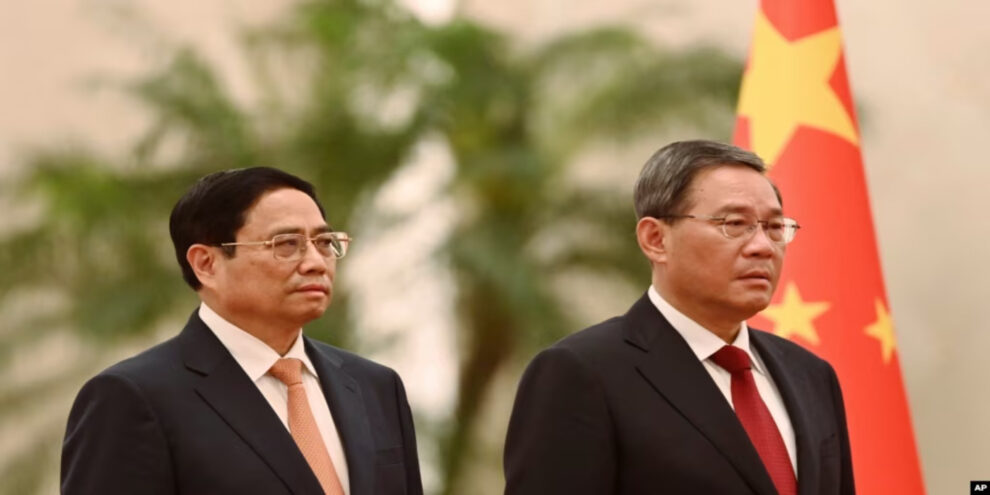Vietnamese Prime Minister Pham Minh Chinh’s four-day visit to Beijing, which coincided with the June 25 arrival of a U.S. aircraft carrier to Vietnam, appears to be an example of Hanoi’s balancing act between the United States and China, analysts said.
The U.S. Navy’s USS Ronald Reagan arrived in Da Nang, Vietnam, for a scheduled five-day port call on June 25, the third time a U.S. aircraft carrier has visited the country since 2018.
That same day, Chinh arrived in Beijing at the invitation of Chinese Premier Li Qiang for an official visit.
“China regards Vietnam as a priority in its neighborhood diplomacy,” China’s Ministry of Foreign Affairs said in a welcome statement that included remarks from Vietnamese Foreign Minister Bui Thanh Son, who is traveling with the prime minister.
“Vietnam regards its relations with China as its top priority, pursues the one-China policy with a clear-cut stance, and firmly supports the development and growth of socialism with Chinese characteristics,” said Son.
The visit by the only U.S. Navy carrier operating in the Indo-Pacific is a highly visible development in U.S.-Vietnam relations.
On Tuesday, Chinese President Xi Jinping met with Chinh and described the two nations “as friends who know each other well,” citing cooperation in areas as varied as people-to-people cooperation, China’s Belt and Road infrastructure projects, and trade, according to China’s officialXinhua News Agency.
“The carrier visit comes as Hanoi faces growing challenges from China’s assertiveness in the South China Sea and as Washington continues to push for raising ties to the level of a strategic partnership,” said Prashanth Parameswaran, a fellow with the Wilson Center’s Asia Program.
Shared concern about China
The United States and Vietnam are marking the 10th anniversary of their comprehensive partnership at a time when the two countries share an increasingly close trade relationship and similar concerns about China’s growing power in the region.
“This visit marks a special occasion as our countries celebrate the 10-year anniversary of the U.S.-Vietnam Comprehensive Partnership, showcasing our shared commitment to a prosperous and secure future,” said a U.S. State Department spokesperson in an email to VOA this week.
The U.S. reestablished diplomatic relations with Vietnam in 1995, 20 years after the fall of Saigon — now Ho Chi Minh City — marked the defeat of U.S. ally South Vietnam.
“We’re excited to come to Vietnam and appreciate the welcome our strike group has received,” Rear Admiral Pat Hannifin said in a press release on June 25.
“Visits like this reinforce our partnership and commitment to confronting shared challenges in the maritime domain. They also provide a great opportunity for our Sailors to engage with the Vietnamese people and culture,” he said.
Vietnam’s Foreign Ministry spokesperson Phạm Thu Hang said the USS Ronald Reagan’s visit to Danang, scheduled to end on June 30, is an “ordinary exchange” that is “meant to contribute to peace, stability, cooperation and development in the region and the world,” the official Vietnam News reported.
China’s Foreign Ministry spokesperson Mao Ning on June 26 responded to a question about the carrier’s visit to Vietnam.
“We hope that efforts to grow relations and have exchanges and cooperation between relevant countries will be conducive to regional peace, stability and prosperity,” she said.
Agreement to manage disputes
On Monday, China’s Li and Chinh agreed that Beijing and Hanoi should manage their differences in their South China Sea dispute, according to China’s official Global Times. Vietnam is just one of the nations in the region disputing China’s territorial claims to the resource-rich waters.
On Tuesday, Chinese Defense Minister Li Shangfu met his Vietnamese counterpart, Phan Van Giang.
During the meeting, Li said China is willing to work with Vietnam to strengthen high-level communication and cooperation between the militaries of the two countries, according to Reuters.
Phan told Li that the Vietnamese military is willing to continue to strengthen cooperation with Beijing in politics, border defense and personnel training, according to the Global Times.
Planned ‘bamboo diplomacy’
Analysts say the visits by the diplomats and the U.S. aircraft carrier were not coincidences, adding that they were well planned by Hanoi, with both visits showing proof of Vietnam’s so-called “bamboo policy” of balancing the interests of competing powers.
The phrase was coined by the general secretary of the Vietnamese Communist Party, Nguyen Phu Trong, in 2016. It describes Hanoi’s “unique and special foreign policy of independence, self-reliance, flexibility, and diversification of relations” according to the official Vietnam+.
“Obviously, China is unhappy” whenever a U.S. aircraft carrier visits Vietnam, Raymond Powell, director of Stanford University’s Project Myoushu in the South China Sea, who observed recent Chinese research vessels entering Vietnam’s exclusive economic zone, told VOA in a phone interview.
“To see the third U.S. aircraft carrier visit to Vietnam — and I think that’s a very positive step — it is something that’s clearly for Vietnam. It takes quite a lot of coordination and political will to allow a U.S. carrier visit,” Powell said.
Asked about the USS Ronald Reagan’s visit to Vietnam, Mao, spokesperson for the Chinese Foreign Ministry, told Agence France-Presse on June 26, “We hope that efforts to grow relations and have exchanges and cooperation between relevant countries will be conducive to regional peace, stability and prosperity.”
A day earlier, she said of Chinh’s visit, “We believe the visit “will strengthen the sound momentum of growth in bilateral relations and promote solid progress in our deepening comprehensive strategic cooperation.”
Source : VOA News















